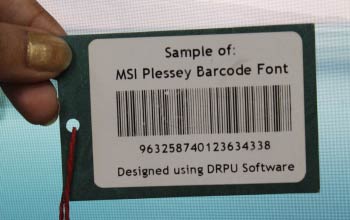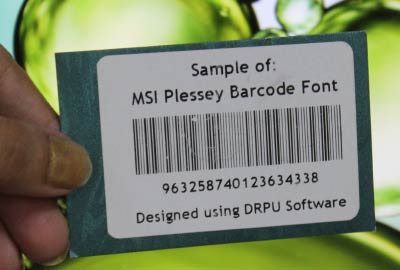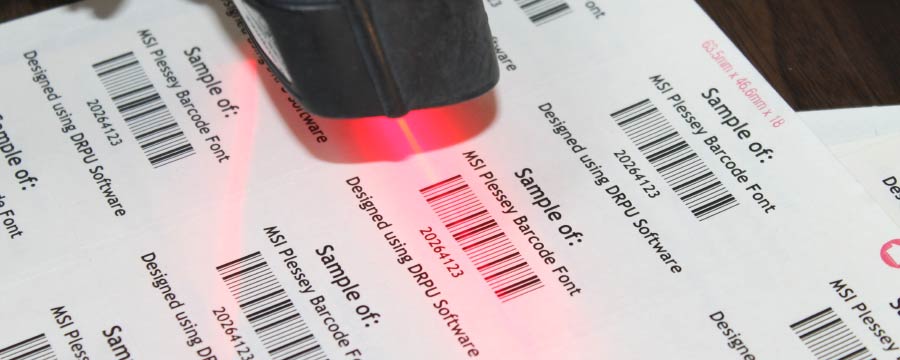Structure of an MSI Plessey Barcode

MSI Plessey is a continuous, self-checking barcode symbology used for inventory and warehouse management, package tracking, and other applications. It was developed by the MSI Data Corporation and is a variation of the Plessey barcode.
The MSI Plessey barcode consists of a series of alternating bars and spaces that represent digits or characters. The barcode starts and ends with a special character known as the guard bar, which indicates the beginning and end of the barcode.
The structure of an MSI Plessey barcode is similar to that of other barcodes in that it contains a series of bars and spaces of varying widths, with each character represented by a unique pattern of bars and spaces. However, unlike other barcodes, MSI Plessey uses a self-checking system to ensure accuracy.
| Structure of MSI Plessey Barcode | |
| Start code | The start code is a unique pattern of bars and spaces that indicates the beginning of the barcode. |
| Data code | The data code is a series of bars and spaces that represent the encoded information, typically a series of numbers. |
| Check digit | The check digit is a digit calculated from the other digits in the barcode and is used to ensure the accuracy of the code. |
| Stop code: | The stop code is a unique pattern of bars and spaces that indicates the end of the barcode. |
MSI Plessey uses a binary system to represent characters, with each digit represented by a unique combination of bars and spaces. The barcode can encode up to 12 digits or characters, including numbers, letters, and special characters.
The bar width of an MSI Plessey barcode can vary between 0.015 inches and 0.04 inches, with a height-to-width ratio of 2.5:1. The minimum width of a space is equal to the minimum width of a bar, and the maximum width of a space is two times the width of a bar.
The structure of an MSI Plessey barcode allows for easy decoding using barcode scanners, which read the barcode by scanning the pattern of bars and spaces and decoding the binary representation of the characters.
In summary, the MSI Plessey barcode is a continuous, self-checking barcode symbology that consists of a series of bars and spaces representing digits or characters. Its unique structure allows for easy decoding using barcode scanners, making it a popular choice for inventory and warehouse management, package tracking, and other applications.
Minimum and Maximum Length of an MSI Plessey Barcode

The minimum and maximum length of an MSI Plessey barcode depend on the specific application and the type of data being encoded. Unlike fixed-length barcodes like UPC and EAN, MSI Plessey barcodes are a variable-length symbology, meaning that the number of characters in the barcode can vary depending on the data being encoded.
The number of characters that can be encoded in an MSI Plessey barcode is determined by the width of the bars and spaces that make up the barcode. Each character in the barcode is represented by a unique pattern of bars and spaces, and the total number of bars and spaces in the barcode must be an even number to maintain the self-checking property of the symbology.
Typically, an MSI Plessey barcode can encode between 1 and 12 digits, but some implementations may allow for up to 16 digits or more. The actual length of the barcode depends on the specific application requirements and the amount of data that needs to be encoded.
In general, shorter MSI Plessey barcodes are easier to read and require less space on a label or product package. Longer barcodes may be more difficult to scan accurately, especially if the print quality or scanning equipment is not optimal.
📋 Note:It is important to note that the maximum length of an MSI Plessey barcode is not determined by the barcode symbology itself, but rather by practical limitations such as print quality, scanner resolution, and the size of the label or product package. In general, longer barcodes may require higher print resolution and scanner resolution to ensure accurate reading, and may also require larger label sizes or product packaging to accommodate the barcode.
Overall, the minimum and maximum length of an MSI Plessey barcode is dependent on a variety of factors, including the specific application requirements, the amount of data to be encoded, and the printing and scanning equipment used.
Characters Encoding in an MSI Plessey Barcode
MSI Plessey is a type of barcode that is mainly used for inventory and tracking purposes in industries such as retail and manufacturing. It is a continuous, variable-length symbology that can encode numeric digits and some punctuation characters. In this article, we will discuss the various characters that can be encoded in an MSI Plessey barcode and how they are represented.
The MSI Plessey barcode can encode the digits from 0 to 9. It does not support the encoding of alphabetic characters, special symbols, or other types of characters. Therefore, MSI Plessey is primarily used for applications where only numeric data needs to be encoded.
The MSI Plessey barcode is a self-checking symbology, which means that it contains a built-in error-detection mechanism. The checksum character is calculated based on the value of the digits encoded in the barcode. This checksum character is then added to the end of the barcode to ensure that the data has been encoded correctly. If the checksum value does not match the calculated value, the barcode is considered to be invalid.
In addition to the digits, the MSI Plessey barcode can also encode some punctuation characters. These characters include:- (-)
Hyphen
The hyphen character can be used to separate two groups of digits within the barcode. For example, if you need to encode the number 123-456, you can use a hyphen to separate them. The hyphen is represented by the value 10 in the barcode.
- (.)
Period
The period character can be used to indicate decimal points within the barcode. For example, if you need to encode the number 12.34, you can use a period to indicate the decimal point. The period is represented by the value 11 in the barcode.
- ($)
Dollar Sign
The dollar sign character can be used to indicate currency values within the barcode. For example, if you need to encode the value $25.00, you can use a dollar sign to indicate the currency. The dollar sign is represented by the value 12 in the barcode.
- (/)
Slash
The slash character can be used to indicate fractions within the barcode. For example, if you need to encode the value 3/4, you can use a slash to indicate the fraction betweeen the two digits. The slash is represented by the value 13 in the barcode.
- (+)
Plus
The plus sign character can be used to indicate positive values within the barcode. For example, if you need to encode the value +10, you can use a plus sign to indicate the positive value. The plus sign is represented by the value 14 in the barcode.
- (%)
Percent
The percent sign character can be used to indicate percentage values. For example, if you need to encode the value 50%, you can use a percent sign to indicate the percentage. The percent sign is represented by the value 15 in the barcode.
- (*)
Asterisk
The asterisk character can be used as a wild card character within the barcode. For example, if you need to encode a variable length data such as a batch or lot number, you can use an asterisk to represent the variable length data. The asterisk is represented by the value 16 in the barcode.
In summary, the MSI Plessey barcode can encode the digits from 0 to 9 and a limited number of punctuation characters. It is primarily used for applications where only numeric data needs to be encoded. The barcode also contains a built-in error-detection mechanism to ensure that the data has been encoded correctly.
International Usage of an MSI Plessey Barcode
MSI Plessey barcode is a linear barcode symbology that was developed by MSI Data Corporation in the 1970s. The barcode is primarily used in the United States for inventory control and tracking applications. While MSI Plessey barcode can be used internationally, its use outside of the United States is limited.

In this article, we will discuss the international use of MSI Plessey barcode and the factors that affect its adoption.
-
🗺Regional Variations in Barcode
Standards
One of the factors that affect the international use of MSI Plessey barcode is the regional variations in barcode standards. Different countries and regions have their own standards for barcode symbologies, which can make it difficult for MSI Plessey barcode to gain acceptance.
For example, the European Article Number (EAN) barcode symbology is widely used in Europe, while the Japan Article Number (JAN) barcode symbology is used in Japan. These barcode symbologies have different encoding schemes and can encode different types of information compared to MSI Plessey barcode. As a result, businesses that operate internationally may need to use different barcode symbologies to comply with local standards.
-
🧩Compatibility with Scanning Devices
Another factor that affects the international use of MSI Plessey barcode is compatibility with scanning devices. Barcode scanning devices may not be compatible with all barcode symbologies, which can limit the adoption of MSI Plessey barcode.
For example, some barcode scanning devices may be designed to only scan specific barcode symbologies, such as EAN or Code 128. These devices may not be able to read MSI Plessey barcode, which can limit its use in certain applications.
-
💰Cost and Availability of Barcode Scanning
Devices
The cost and availability of barcode scanning devices can also affect the international use of MSI Plessey barcode. In some countries, barcode scanning devices may be expensive and difficult to obtain, which can limit the adoption of MSI Plessey barcode.
In addition, the availability of technical support and maintenance services for barcode scanning devices can also affect the adoption of MSI Plessey barcode. If businesses are unable to obtain technical support or maintenance services for their barcode scanning devices, they may be less likely to adopt MSI Plessey barcode.
-
💻Application Requirements
The requirements of specific applications can also affect the international use of MSI Plessey barcode. For example, certain applications may require the encoding of more than 10 digits, which is the maximum number of digits that can be encoded in MSI Plessey barcode. In these cases, other barcode symbologies may be more suitable for the application.
In addition, some applications may require the use of 2D barcode symbologies, such as QR code or Data Matrix, which can encode more information in a smaller space compared to linear barcode symbologies. In these cases, MSI Plessey barcode may not be suitable for the application.
MSI Plessey barcode can be used internationally, but its use is limited by regional variations in barcode standards, compatibility with scanning devices, cost and availability of barcode scanning devices, and application requirements. Businesses that operate internationally may need to use different barcode symbologies to comply with local standards and meet the requirements of specific applications. The choice of barcode symbology will depend on a variety of factors, including the type of information that needs to be encoded, the scanning distance, and the compatibility with scanning devices.